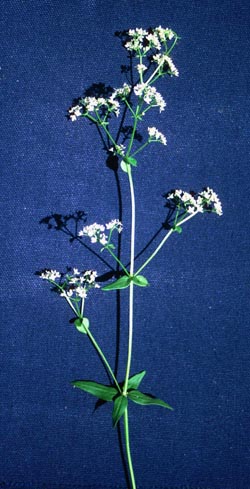Northern Bedstraw

Common Name(s):
Northern Bedstraw
Bedstraw
Scientific Name:
Galium boreale L.
Scientific Name Synonyms:
Galium hyssopifolium Hoffman
Galium septentrionale Roemer & J.A. Schultes
Galium strictum Torr.
Symbol:
GABO2
Description:
Life Span: Perennial
Origin: Native
Growth Characteristics: Northern bedstraw grows on an upright, smooth stems, 7 to 30 inches tall. It spreads by creeping roots and self-seeding. Flowering occurs in late spring and early summer.
Flowers: Tiny white flowers appear in numerous, rather showy, repeatedly 3-forked clusters. Petals are white or slightly creamy, 3.5-7mm wide, with 4 spreading lobes which are separate almost to the base.
Fruits/Seeds: Pairs of nutlets, about 2 mm long, softly hairy with short, straight or curled, but not hooked, hairs that are inconspicuous to the naked eye, or hairless.
Leaves: Northern bedstraw leaves are narrow, ½ inch wide, up to 2 inches long, and appear along the stems in whorls of four. There are three prominent veins on the leaves.
Stems: Numerous erect, square stems. The stem is commonly short-bearded just beneath the nodes, otherwise it’s hairless or slightly rough.
Roots: Creeping rhizomes
Ecological Adaptions:
Northern bedstraw is found on rock ledges, stony ground and streambanks in a wide variety of somewhat moist habitats, from the plains to the timber line. It prefers part shade.
Soils: Prefers moist, well-drained soils.
Associated Species: Douglas Fir, American bistort, heartleaf arnica, Rocky Mountain junipe.
Uses and Management:
Bedstraw is not particularly palatable to livestock and native ungulates, but often makes up a small portion of their diets. Usage may increase with stocking rates or with length of grazing time. While not necessarily an important food source for herbivores, bedstraw is an early season food source for black bears. The presence of bedstraw indicates important elk, deer, and moose habitats.
Northern bedstraw was used to slow bleeding, ease childbirth, increase the appetite, and reduce fever. The plant was boiled to make a wash to remove freckles. When the seeds are roasted, they can be used like coffee. The leaves can curdle milk to make cheese. Continual use of this plant will irritate the mouth.

